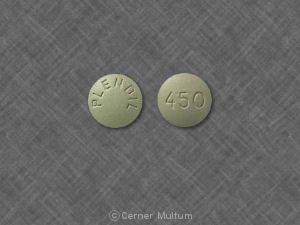Plendil Side Effects
Generic name: felodipine
Medically reviewed by Drugs.com. Last updated on Sep 17, 2023.
Note: This document contains side effect information about felodipine. Some dosage forms listed on this page may not apply to the brand name Plendil.
Applies to felodipine: oral tablet extended release.
Serious side effects of Plendil
Along with its needed effects, felodipine (the active ingredient contained in Plendil) may cause some unwanted effects. Although not all of these side effects may occur, if they do occur they may need medical attention.
Check with your doctor immediately if any of the following side effects occur while taking felodipine:
More common
- Bloating or swelling of face, arms, hands, lower legs, or feet
- rapid weight gain
- tingling of hands or feet
- unusual weight gain or loss
Less common
- Body aches or pain
- chills
- cough
- difficulty in breathing
- ear congestion
- fever
- headache
- loss of voice
- nasal congestion
- runny nose
- sneezing
- sore throat
- unusual tiredness or weakness
Incidence not known
- Blurred vision
- chest pain, tightness, or heaviness
- confusion
- congestion
- cough producing mucus
- diarrhea
- dizziness, faintness, or lightheadedness when getting up from a lying or sitting position suddenly
- fast, slow, or irregular heartbeat
- general feeling of discomfort or illness
- hoarseness
- joint pain
- large, hive-like swelling on face, eyelids, lips, tongue, throat, hands, legs, feet, or sex organs
- loss of appetite
- muscle aches and pains
- nausea
- pain or discomfort in arms, jaw, back, or neck
- pale skin
- shivering
- shortness of breath
- sweating
- swelling or puffiness of face
- tender or swollen glands in neck
- trouble in swallowing
- trouble sleeping
- troubled breathing with exertion
- unusual bleeding or bruising
- voice changes
- wheezing
Get emergency help immediately if any of the following symptoms of overdose occur while taking felodipine:
Symptoms of overdose
- Feeling of warmth
- redness of the face, neck, arms and occasionally, upper chest
Other side effects of Plendil
Some side effects of felodipine may occur that usually do not need medical attention. These side effects may go away during treatment as your body adjusts to the medicine. Also, your health care professional may be able to tell you about ways to prevent or reduce some of these side effects.
Check with your health care professional if any of the following side effects continue or are bothersome or if you have any questions about them:
Less common
- Acid or sour stomach
- belching
- burning, crawling, itching, numbness, prickling, "pins and needles", or tingling feelings
- constipation
- heartburn
- indigestion
- lack or loss of strength
- skin rash
- stomach discomfort, upset, or pain
Rare
- Bleeding gums
- irritation in mouth
- redness and swelling of gums
Incidence not known
- Bloated or full feeling
- bloody nose
- burning while urinating
- decreased interest in sexual intercourse
- difficult or painful urination
- difficulty in moving
- discouragement
- disturbed color perception
- double vision
- dry mouth
- excess air or gas in stomach or intestines
- feeling sad or empty
- fear or nervousness
- frequent strong or increased urge to urinate
- halos around lights
- hives or welts
- inability to have or keep an erection
- increased need to urinate
- increased volume of pale or dilute urine
- irritability
- itching
- loss in sexual ability, desire, drive, or performance
- loss of interest or pleasure
- muscle cramps or stiffness
- night blindness
- overbright appearance of lights
- pain or tenderness around eyes and cheekbones
- passing gas
- passing urine more often
- redness of skin
- sleepiness or unusual drowsiness
- sleeplessness
- sores, welting, or blisters
- swelling of the breasts or breast soreness in both females and males
- swollen joints
- tiredness
- trouble concentrating
- tunnel vision
- unable to sleep
For Healthcare Professionals
Applies to felodipine: oral tablet extended release.
General
The most common adverse events were peripheral edema and headache.[Ref]
Other
Very common (10% or more): Peripheral edema (up to 17.4%)
Common (1% to 10%): Asthenia, warm sensation
Frequency not reported: Chest pain, facial edema, flu-like illness, influenza[Ref]
Peripheral edema was generally mild, but it was age and dose related. It resulted in treatment discontinuation in about 3% of patients.[Ref]
Nervous system
Very common (10% or more): Headache (up to 14.7%)
Common (1% to 10%): Dizziness, paresthesia
Frequency not reported: Syncope, somnolence[Ref]
Gastrointestinal
Common (1% to 10%): Nausea, dyspepsia, constipation
Frequency not reported: Abdominal pain, diarrhea, vomiting, dry mouth, flatulence, acid regurgitation, gingival hyperplasia[Ref]
Respiratory
Common (1% to 10%): Cough, rhinorrhea, sneezing
Frequency not reported: Dyspnea, pharyngitis, bronchitis, sinusitis, epistaxis, respiratory infection[Ref]
Cardiovascular
Common (1% to 10%): Palpitation, flushing
Frequency not reported: Myocardial infarction, hypotension, angina pectoris, arrhythmia, tachycardia, premature beats[Ref]
Dermatologic
Common (1% to 10%): Rash
Frequency not reported: Angioedema, contusion, erythema, urticaria, leukocytoclastic vasculitis[Ref]
Musculoskeletal
Frequency not reported: Arthralgia, back pain, leg pain, foot pain, muscle cramps, myalgia, arm pain, knee pain, hip pain[Ref]
Psychiatric
Frequency not reported: Insomnia, depression, anxiety disorders, irritability, nervousness, libido decreased[Ref]
Genitourinary
Frequency not reported: Impotence, urinary frequency, urinary urgency, dysuria, polyuria[Ref]
Endocrine
Frequency not reported: Gynecomastia[Ref]
Hematologic
Frequency not reported: Anemia[Ref]
Hepatic
Frequency not reported: ALT increased[Ref]
Ocular
Frequency not reported: Visual disturbances[Ref]
More about Plendil (felodipine)
- Check interactions
- Compare alternatives
- Reviews (2)
- Drug images
- Side effects
- Dosage information
- During pregnancy
- Drug class: calcium channel blocking agents
- Breastfeeding
Patient resources
Professional resources
Related treatment guides
References
1. Product Information. Plendil (felodipine). Merck & Co., Inc. 2002;PROD.
Further information
Always consult your healthcare provider to ensure the information displayed on this page applies to your personal circumstances.
Some side effects may not be reported. You may report them to the FDA.

